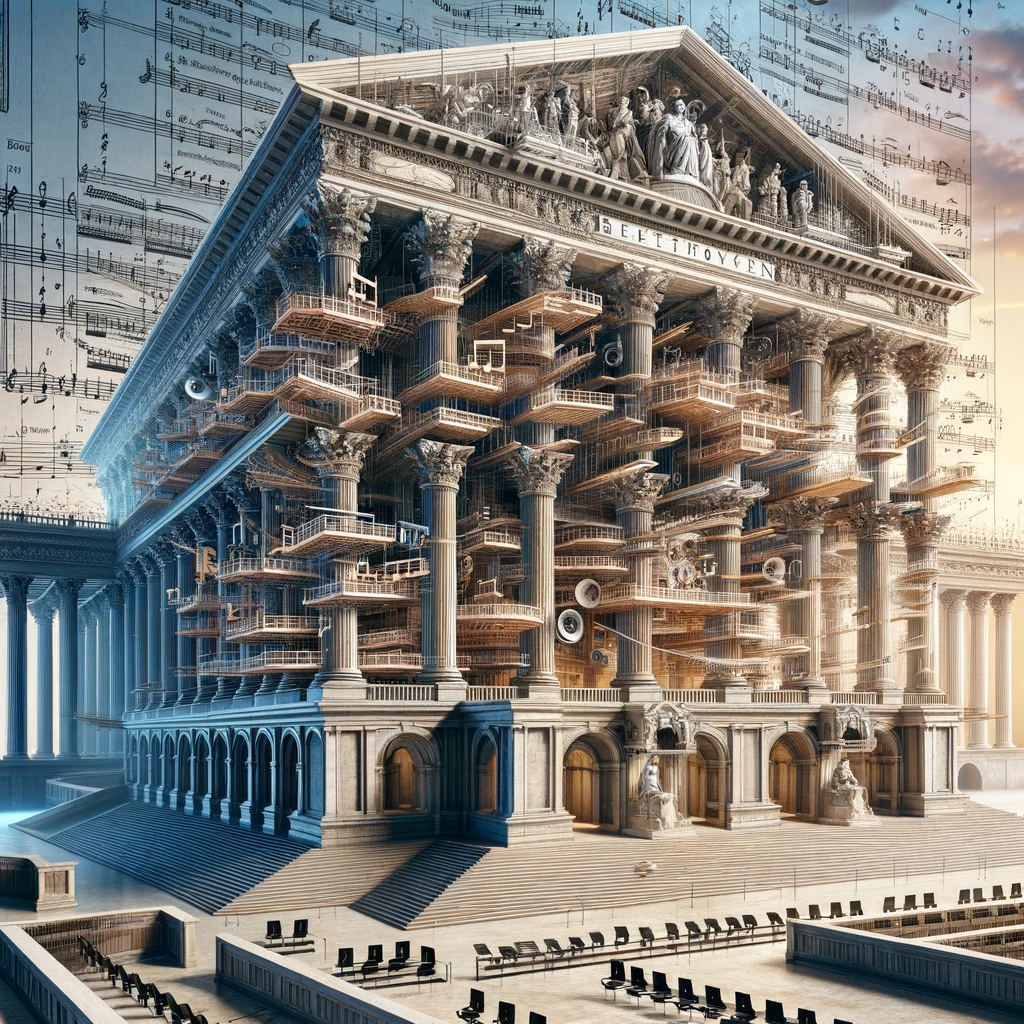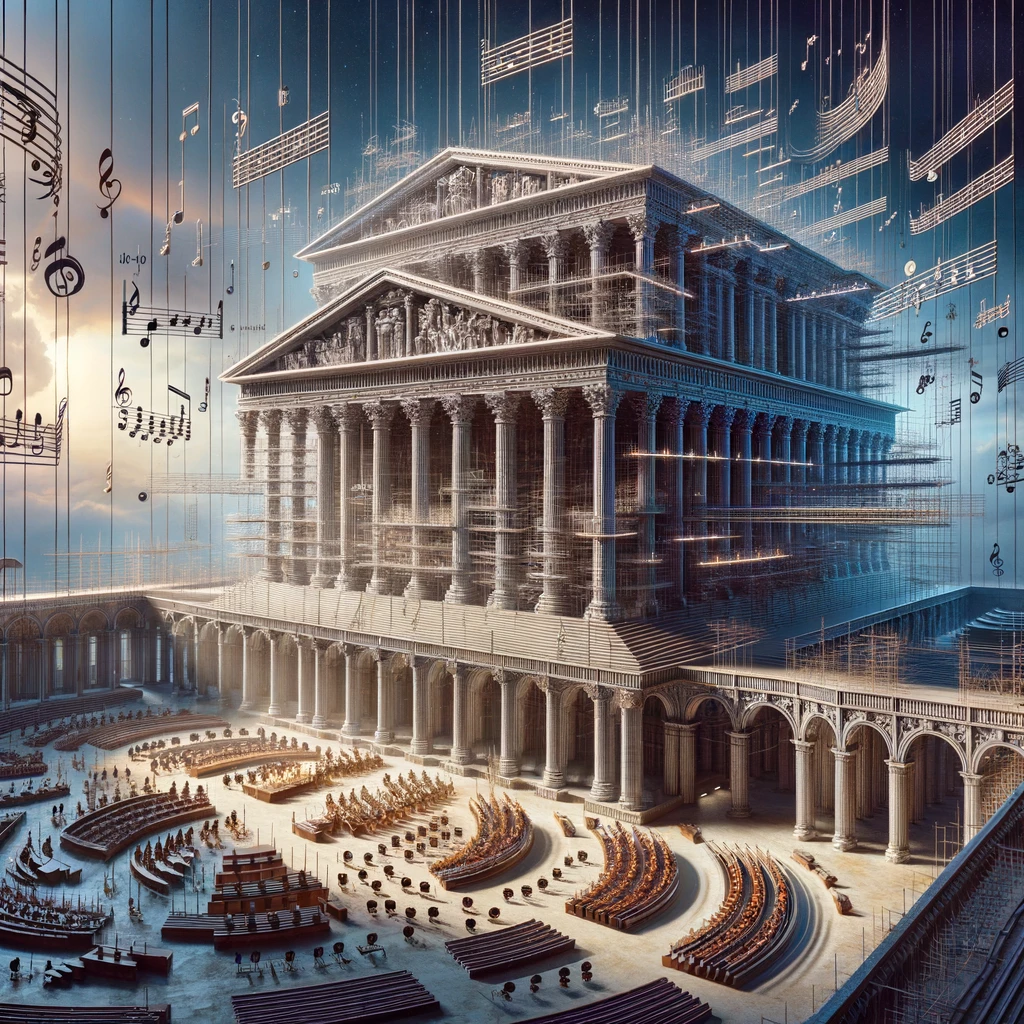
Exploring Beethoven’s Musical Structures
Ludwig van Beethoven is often remembered for his profound impact on classical music, pushing boundaries and challenging conventions. His works are celebrated not just for their emotional depth, but also for their structural innovation. In exploring the architecture of Beethoven’s music, we discover how meticulously crafted frameworks allowed his compositions to resonate through ages, combining complexity with accessibility in ways that were revolutionary at the time.
The Foundations: Early Influences and Developments
Beethoven’s journey into musical architecture began with his early education, where he was steeped in the traditions of Bach and Mozart. From Bach, Beethoven learned the intricacies of counterpoint—a method of composing music with multiple independent lines of melody. Mozart’s influence, meanwhile, was evident in Beethoven’s initial foray into form and harmony. These foundational elements were the bedrock on which he built his unique style. In his early works, you can hear him experimenting with these forms, extending phrases and modulating key signatures in ways that surprised and delighted his audience.
Building Complexity: Innovations in Structure
As Beethoven’s career progressed, so did his ambition to expand the traditional forms of music. One of his most significant contributions was the transformation of the sonata form, particularly evident in his symphonies and sonatas. The sonata form, a structure used widely during the Classical period, typically consists of three main sections: exposition, development, and recapitulation. Beethoven took this structure and infused it with a level of dramatic tension and resolution that had not been seen before.
For example, in his “Fifth Symphony,” the famous four-note motif (“short-short-short-long”) is not just an opening idea but serves as a structural pillar that recurs throughout the movement, each time reappearing with new harmonies, textures, and orchestral colors. This thematic development keeps the listener engaged and creates a sense of unity across the movement.
The Emotional Landscape: Harmony and Motivic Development
Beethoven’s ability to convey deep emotion through structural elements is perhaps best showcased in his use of harmony. He often employed unconventional key changes and modulations to evoke a wide range of emotional responses. His “Pathétique” Sonata, for instance, begins with a dramatic and somber tone in the key of C minor, which he juxtaposes with a lyrical and hopeful second theme in E-flat major. This stark contrast not only heightens the emotional impact but also illustrates his masterful control over the musical architecture.
Moreover, Beethoven’s use of motivic development—where a small musical idea or motif is repeated and varied throughout a piece—allowed him to build complex structures from simple beginnings. This technique is vividly apparent in his “Diabelli Variations,” where a seemingly trivial waltz by Anton Diabelli is transformed into 33 variations, each with its own unique character and complexity.
The Legacy: Beethoven’s Structural Brilliance
The true genius of Beethoven’s structural innovations lies in their ability to support and enhance the expressive power of his music. By meticulously organizing musical ideas, he was not merely showing off technical prowess but was using structure as a tool to deepen the listener’s emotional experience. This approach has influenced countless composers and musicians who followed, shaping the evolution of Western classical music.
Beethoven’s architectural approach to music was revolutionary. His structures, while complex, never overshadowed the emotional and expressive qualities of his work. Instead, they enhanced them, allowing each piece to communicate more profoundly, and ensuring his legacy would resonate well beyond his time. Beethoven did not just compose music; he constructed emotional experiences, inviting listeners to explore the depths of human feeling within the framework of sound. His contributions remind us that at the heart of great music lies not only melody and harmony but a profound understanding of structure and form.

Beethoven’s approach to symphonic writing, particularly through his later symphonies, underscores his architectural prowess. The “Ninth Symphony,” for instance, is a monumental work that not only expanded the scope of symphonic music but also integrated voices into a symphonic framework for the first time. This symphony’s final movement, the “Ode to Joy,” is a vivid example of how Beethoven was able to architecturally blend choral and orchestral elements to create a powerful, unified expression of universal brotherhood. The movement builds on themes introduced in earlier movements, culminating in a complex yet accessible finale that has resonated with audiences worldwide.
Integration of Theatrical Elements
Beethoven’s music often resembled a dramatic narrative, with each piece telling a story or painting a scene. This theatrical element in his compositions further highlights the architectural brilliance in his work. For instance, the “Pastoral Symphony” (Symphony No. 6) vividly depicts the essence of nature. Each movement is titled to reflect the scene it represents, such as “Awakening of cheerful feelings upon arrival in the countryside” or “Thunder, Storm.” Here, Beethoven uses tonal painting to craft scenes, using the orchestration to mimic natural sounds and settings. This approach not only creates an auditory landscape but also structures the symphony as a series of interconnected scenes, each contributing to a coherent whole.
Contrasting Dynamics and Textures
Another dimension of Beethoven’s musical architecture is his innovative use of dynamics and textures. His compositions frequently shift between loud and soft, dense and sparse, creating an effect akin to moving through different spaces in a building. In the “Piano Sonata No. 14,” popularly known as the “Moonlight Sonata,” the sudden contrast between the serene, gentle first movement and the turbulent, vigorous third movement creates a dramatic structural contrast that is emotionally compelling and structurally significant.
Mastering Variational Form
Beethoven’s mastery of variational form also exemplifies his structural innovation. The “Eroica Variations” (Op. 35) start with a simple bass line and evolve into complex variations that explore a wide range of piano techniques and harmonic explorations. Each variation is not just a modification of the theme but a complete reimagining that maintains structural coherence while showcasing creative genius.
Conclusion: A Legacy of Structural Brilliance
Beethoven’s contributions to musical form and structure cannot be overstated. His works pushed the boundaries of what was musically possible, and his innovations continue to influence the music world today. The structural elements of his compositions are not just frameworks; they are integral to the expressive power and timeless quality of his music. Beethoven’s legacy is that of a composer who could think architecturally, using the full spectrum of musical elements to craft works that were innovative, emotional, and structurally brilliant.
As we continue to study and enjoy Beethoven’s music, it becomes clear that his genius lay in his ability to integrate form, motif, harmony, and texture to create not just music, but profound aural experiences that continue to inspire and move audiences around the globe. Beethoven’s architectural approach to music-making ensures that his works remain relevant, engaging, and revolutionary, bridging centuries and touching the souls of all who listen.
This exploration into the structural brilliance of Beethoven’s music highlights how his architectural approach to composition not only enriched the aesthetic value of his works but also set new standards in the musical domain. Beethoven’s legacy as a musical architect is characterized by his ability to blend technical mastery with profound emotional depth, creating an enduring impact on the world of classical music.